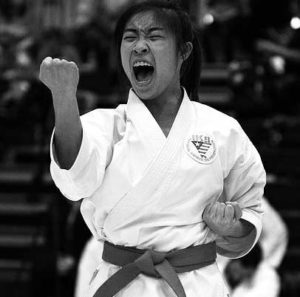 I already gave you my interpretation of Kiai in part 1, and as such, I will not go into depth with this again. Nonetheless, it can’t be avoided that I get into the topic anyway, as concepts like Kime, Kiai, and breathing are unequivocally related.
I already gave you my interpretation of Kiai in part 1, and as such, I will not go into depth with this again. Nonetheless, it can’t be avoided that I get into the topic anyway, as concepts like Kime, Kiai, and breathing are unequivocally related.
Most of all, in the following I will deal with a new concept, namely Kake-goe!
Kake-goe
The definition: “Kake-goe is a melodramatic shout from an audience in connection with performances in a Japanese kabuki theater, or in connection with traditional Japanese music and especially Kendo.” Kake-goe is only to cheer others and ourselves up.
Kake-goe can have different meanings depending on the context in which it is used. Just watch a weightlifter, or a 100-meter sprinter, who breaks his record, and subsequently exclaims the person in a wild and unrestrained scream, that’s what Kake-goe is. The person shows his joy, strength, and mental surplus.
The shout is to encourage ourselves as well as others. The shouts are also used in a synchronized mode in a crowd to show their strength. A good shout can be overwhelming for the opponent, and at the same time show strength, both physically and mentally. However, it does not necessarily contribute to the victory.
I have seen fighters shouting before a fight to get mentally ready. Sometimes they have “slap” themselves to set the fighting spirit in motion or get others to do it. It works amazingly well and they are “fully turned on” before the fight. However, if they lose the fight, then the shouting and slapping are not as effective anyway.
I think that the modern version of sportskarate-Kiai and Kake-goe are related, or maybe the same.
Questions: After all, is it necessary with all that shouting and screaming?
Reply: Yes, as it has a certain effect and impact on our body and mind.
When you attack another person and in that context give a shout from you, the person being attacked can be overwhelmed by the shout. For me, this is Kake-goe and not Kiai.
Examples of using
